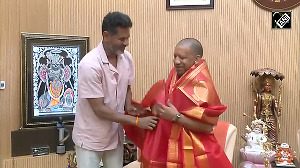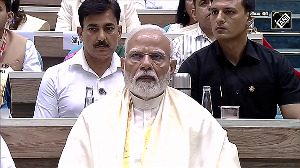'The problems that the film explores still remain.'
'It was a different time when we made the film. We were young and we thought we could change the world.'

This year's Cannes Film Festival has a rich bouquet of Indian films, seven in total, including one in the festival's main competition section. One of the seven films is Shyam Benegal's 48-year-old Manthan, which will be screened in the Cannes Classic section.
The team behind bringing the 4K restored version of Manthan to Cannes is the Mumbai-based Film Heritage Foundation, headed by Shivendra Singh Dungarpur.
This will be the third film restored under guidance of the foundation to be shown at Cannes. The other two films are Govindan Aravindan's 1978 film Thamp in 2022 and Aribam Syam Sharma's 1990 Manipuri film Ishanou in 2023.
Manthan is inspired by the personal account of Dr Verghese Kurien, a dairy engineer and social entrepreneur, who set up a milk cooperative in Gujarat that eventually became Amul.
Benegal wrote the film's story with Dr Kurien and brought in Kaifi Azmi to work on the dialogues. Benegal's film explores the caste and class politics in rural India, and the challenges in establishing a cooperative society that is supposed to benefit all.
The film stars a large ensemble of actors who worked regularly with Benegal, including Smita Patil, Girish Karnard, Naseeruddin Shah, Anant Nag, Amrish Puri, Mohan Agashe, and Kulbhushan Kharbanda. Manthan was India's first crowd funded film where 500,000 farmers contributed Rs 2 each to finance the project.
The Cannes screening will be attended by Naseer, Dungarpur and members of Patil's family.
Ahead of the film's screening at Cannes, Aseem Chhabra speaks to Mr Benegal, Naseer and Dungarpur about the new restored print of Manthan.
"When we made the film, the quality of the print was nowhere close to what it is now. Govind Nihalani shot the film so well but the final print was patchwork. Now the way you will see it, that is how it should have been. It's an achievement," Benegal says.
Shyam Babu, how did you feel when you watched the restored film? It's one of your best films and I believe one of your favourites as well.
Shyam Benegal: I saw the film when the restoration was in progress. I saw the very first reel of it. It never looked as good as it does now.
When we made the film, the quality of the print was nowhere close to what it is now. It's unbelievable, almost like a miracle.
The Film Heritage Foundation have done an outstanding job.
When Manthan was shot, it was not on Kodak. A bit of it was shot on Geva stock that came from East Germany and some on Eastman. India stopped importing Eastman stock after that.
Govind Nihalani shot the film so well, but the final print was patchwork. Now the way you will see it, that is how it should have been. It's an achievement.
Were there any memories that came back to you, any scenes you thought of when you watched the new version of the film?
Mr Benegal: Oh many memories!
It was probably Smita's career best performance. The performances are all so good.
If you look at the work that Naseer, Mohan Agashe and Kulbhushan (Kharbanda) have done, that's a whole generation of Indian actors who later had wonderful careers.
Of course the song, Maro Gam Katha Pare, in Preeti Sagar's voice, which became the film's theme song.
The sequence when Girish Karnad leaves the village. There is an unspoken relationship between his and Smita's character.
The song was written in half Gujarati and half Hindi, almost a dialect which we invented. It works very well with the film.
The film was shown at the United Nations General Assembly when Dr Kurien was still alive. It was kind of a world premiere, a landmark event. Anyway, that's history, of course.

Naseer sir, I have the same question for you. What was your reaction when you saw the restored film and your younger self on screen?
Naseeruddin Shah: I saw Manthan a few years ago at a screening at the Otters Club (Bandra, north west Mumbai). But this restored version is stunning. The film looks contemporary.
It's interesting that you say the film looks contemporary. I guess rural India has not changed in the past 48 years.
Naseeruddin Shah: That's right. The problems that the film explores still remain.
It was a different time when we made the film. We were young and we thought we could change the world.
Manthan has a lot of energy.
I remember during the shooting of Manthan, I lived in a hut, learnt to make cow dung cakes and milk a buffalo. In order to get into my character I would carry buckets of milk to the unit.
Manthan was one of Shyam's biggest successes. But sadly, most of my co-actors are not here. Only Mohan Agashe is living in Pune and Anant Nag has become a politician.
Are you excited about the opportunity of watching the restored print with the audience in Cannes? You are the only actor who will represent the film.
Naseeruddin Shah: I don't like to go to festivals. But it will be interesting to watch the film, especially with a non-Indian audience.

Shyam Babu, this is a question I would ask Shivendra also, but why did you choose to restore Manthan? I know Kunal Kapoor has restored Junoon and Kalyug.
Mr Benegal: That had partly got to do with Dr Kurien's story. He stayed back in Gujarat.
Manthan is, of course, a fictionalised account of his life.
He got off the train in Anand and some farmers came to him saying their animals were not well. He said, 'I am not a doctor in that sense, but I can come and check.'
And he never left.
Manthan has a lot of significance. For one, it was made by half a million farmers. Fortunately, it turned out to be really good.
Some people may have watched it on YouTube. But now it can have a proper release in theatres, without people thinking of it only as some sort of historical curiosity.
Shivendra, what are your reasons for having selected Manthan to restore?
I saw Manthan for the first at the Film and Television Institute of India.
It is remarkable that the film was produced by 500,000 farmers and their cooperative.
It could have been a dull, boring film, but Shyam Babu made it such an engaging, human story.
He would often say how he wished Manthan was restored.
We could have waited for the 50th anniversary of Manthan, but I realised that the negative will not be in that great condition because there were already molds and fungus on the sides of the negative. There was danger of the negative getting lost. The sound negative was already gone.

How long was the restoration process?
The process started three years ago in terms of the concept, and to get all the permissions.
Since the film rights are owned by the cooperative, Shyam Babu spoke to the organisation and told them that Dr Verghese Kurien's wishes and vision had to be restored. The final restoration was done by the Prasad Digital Film Lab in Chennai.
How many films has the Film Heritage Foundation restored to date?
We have been involved in restoration with partners right from Uday Shankar's Kalpana (1948). That started our journey.
That restoration was done in 2008 by Martin Scorsese's Film Foundation. Since then, we have been involved in several restoration projects.
What are the criteria for picking films to restore?
One is the importance of the film. Specifically with regional cinema or films from around India. Then it is the material, the conditions of the prints, negatives.
This year in addition to Manthan, we have two other important films restored, Nirad Mohapatra's Odia film Maya Miriga (1984) and Girish Kasaravalli's Ghatashraddha (1977).
In the pipeline are Uttra (2000), Dev Benegal's English August (1994) and In Which Annie Gives It Those Ones (1989), with Arundhati Roy.
We are working with partners on restoring Badnam Basti (1971), Sholay (1975) and Do Bigha Zamin (1953).
We will also restore Araner Din Ratri (1970), where we are working with the Film Foundation and Wes Anderson.
It's always a collaborative process. For Do Bigha Zamin, we got the materials in India, the scanning was done at L'Immagine Ritrovata in Bologna and the Criterion Collection is managing the actual restoration.

I recall something you have said in the past, that you want to share the restored films with the public.
A very important issue about restoration is how do you bring back the films to the public.
Ishanou and Thamp are releasing in UK and France. Thamp is also releasing on Blu-ray.
With Manthan, the first thing we will do after Cannes is to plan a big release in India. We want to bring it back to the public.
You had that experience of showing Amitabh Bachchan, Dev Anand and Dilip Kumar's restored films, although your foundation was not involved in the restoration process. And the audience loved watching the old classic films on the big screens.
Absolutely. It's a joy to bring back these classic films.
This year, we will hold a similar festival to mark Raj Kapoor's 100th birth anniversary.











 © 2025
© 2025